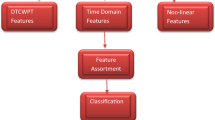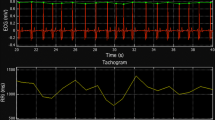Abstract
Traditional Poincaré plot analysis (PPA) represents a two-dimensional graphical and quantitative representation of a time series dynamics. However, traditional PPA indices measure mainly linear aspects of the heart rate variability (HRV).
Therefore, we introduced a new method of PPA - the segmented Poincaré plot analysis (SPPA) that retains essential nonlinear characteristics of the HRV and other time series.
Additional insights into the underlying physiological mechanisms have been gained by extending the methodology of SPPA. Thus we developed the lagged SPPA (LSPPA) that investigates time correlations of the BBI.
For the first time we could demonstrate that an HRV index from SPPA was able to contribute to risk stratification in patients suffering from DCM. LSPPA provides a prognostic preview for DCM patients regarding several associated symptoms such as endothelial dysfunctions and increased risk stratification in DCM to 92% accuracy.
SPPA was also applied to BBI time series and blood pressure signals to investigate the coupling between those two time series.
In several studies we could demonstrate that the applications of SPPA and LSPPA lead to much more information about impaired autonomic regulation and have the potential to be applied in much more fields of medical diagnosis and risk stratification.
Access this chapter
Tax calculation will be finalised at checkout
Purchases are for personal use only
Similar content being viewed by others
References
B.M. Sayers, Analysis of heart rate variability. Ergonomics 16(1), 17–32 (1973)
Task Force of the European Society of Cardiology the North American Society of Pacing Electrophysiology, Heart rate variability: standards of measurement, physiological interpretation, and clinical use. Circulation 93(5), 1043–1065 (1996)
M.A. Woo, W.G. Stevenson, D.K. Moser, H.R. Middlekauff, Complex heart rate variability and serum norepinephrine levels in patients with advanced heart failure. J. Am. Coll. Cardiol. 23(3), 565–569 (1994)
P.W. Kamen, Heart rate variability. Aust. Fam. Physician 25, 1087–1094 (1996)
P.W. Kamen, A.M. Tonkin, Application of the poincar plot to heart rate variability: a new measure of functional status in heart failure. Aust. NZ. J. Med. 25, 18–26 (1995)
M.A. Woo, W.G. Stevenson, D.K. Moser, R.B. Trelease, R.M. Harper, Patterns of beat-to-beat heart rate variability in advanced heart failure. Am. Heart J. 123(3), 704–710 (1992)
M. Brennan, M. Palaniswami, P. Kamen, Do existing measures of poincare plot geometry reflect nonlinear features of heart rate variability. IEEE Trans. Biomed. Eng. 48, 1342–1347 (2001)
U.R. Acharya, K.P. Joseph, N. Kannathal, C.M. Lim, J.S. Suri, Heart rate variability: a review. Med. Biol. Eng. Comput. 44(12), 1031–1051 (2006)
M. Brennan, M. Palaniswami, P. Kamen, Poincare plot interpretation using a physiological model of hrv based on a network of oscillators. Am. J. Physiol. Heart Circ. Physiol. 283, 1873–1886 (2002)
J.T. Bigger Jr., J.L. Fleiss, R.C. Steinman, L.M. Rolnitzky, W.J. Schneider, P.K. Stein, Rr variability in healthy, middle-aged persons compared with patients with chronic coronary heart disease or recent acute myocardial infarction. Circulation 91(7), 1936–1943 (1995)
J. Theiler, S. Eubank, A. Longtin, B. Galdrikian, J.D. Farmer, Testing for nonlinearity in time series: the method of surrogate data. Physica 58, 77–94 (1992)
A. Babloyantz, A. Destexhe, Is the normal heart a periodic oscillator? Biol. Cybern. 58(3), 203–211 (1988)
W. Grimm, P. Alter, B. Maisch, Arrhythmia risk stratification with regard to prophylactic implantable defibrillator therapy in patients with dilated cardiomyopathy. results of macas, definite, and scd-heft. Herz 29(3), 348–352 (2004)
A. Voss, R. Schroeder, S. Truebner, M. Goernig, H.R. Figulla, A. Schirdewan, Comparison of nonlinear methods symbolic dynamics, detrended fluctuation, and poincare plot analysis in risk stratification in patients with dilated cardiomyopathy. Chaos 17(1), 0151201 (2007)
A. Voss, C. Fischer, R. Schroeder, H.R. Figulla, M. Goernig, Segmented poincaré plot analysis for risk stratification in patients with dilated cardiomyopathy. Methods Inf. Med. 49(5), 511–515 (2010)
A. Voss, C. Fischer, R. Schroeder, H.R. Figulla, M. Goernig, Lagged segmented poincaré plot analysis for risk stratification in patients with dilated cardiomyopathy. Med. Biol. Eng. Comput. 50, 727–736 (2012)
W. Grimm, M. Christ, J. Bach, H.H. Muller, B. Maisch, Noninvasive arrhythmia risk stratification in idiopathic dilated cardiomyopathy: results of the marburg cardiomyopathy study. Circulation 108(23), 2883–2891 (2003)
J. Piskorski, P. Guzik, Filtering poincaré plots. Comput. Method. Sci. Technol. 11(1), 39–48 (2005)
R. Moe-Nilssen, J.L. Helbostad, Estimation of gait cycle characteristics by trunk accelerometry. J. Biomech. 37(1), 121–126 (2004)
D. Hoyer, U. Leder, H. Hoyer, B. Pompe, M. Sommer, U. Zwiener, Mutual information and phase dependencies: measures of reduced nonlinear cardiorespiratory interactions after myocardial infarction. Med. Eng. Phys. 24(1), 33–43 (2002)
S.G. Priori, E. Aliot, C. Blomstrom-Lundqvist, L. Bossaert, G. Breithardt, P. Brugada, A.J. Camm, R. Cappato, S.M. Cobbe, C. Di Mario, B.J. Maron, W.J. McKenna, A.K. Pedersen, U. Ravens, P.J. Schwartz, M. Trusz-Gluza, P. Vardas, H.J. Wellens, D.P. Zipes, Task force on sudden cardiac death of the european society of cardiology. Eur. Heart J. 22(16), 1374–1450 (2001)
P. Schirdewahn, A. Dorszewski, G. Hindricks, R. Kobza, H. Kottkamp, H. Tanner, Plötzlicher herztod und icd-therapie. J. Kardiol. 11, 3–10 (2004)
S.B. Mohan, M. Parker, M. Wehbi, P. Douglass, Idiopathic dilated cardiomyopathy: a common but mystifying cause of heart failure. Cleve. Clin. J. Med. 69(6), 481–487 (2002)
N. Wessel, A. Voss, H. Malberg, C. Ziehmann, H.U. Voss, A. Schirdewan, U. Meyerfeldt, J. Kurths, Nonlinear analysis of complex phenomena in cardiological data. Herzschr. Elektrophys. 11, 159–173 (2000)
O. Przibille, A. Liebrich, B. Nowak, S. Rosocha, C.H. Zellerhoff, S. Geil, E. Himmrich, N. Treese, J. Meyer, Prognostic significance of analysis of heart rate variability in patients with dilated cardiomyopathy. Z Kardiol. 87(6), 453–458 (1998)
F. Lombardi, Chaos theory, heart rate variability, and arrhythmic mortality. Circulation 101(1), 8–10 (2000)
H.V. Huikuri, J.S. Perkiomaki, R. Maestri, G.D. Pinna, Clinical impact of evaluation of cardiovascular control by novel methods of heart rate dynamics. Philos. Trans. A Math. Phys. Eng. Sci. 367(1892), 1223–1238 (2009)
A.E. Aubert, B. Seps, F. Beckers, Heart rate variability in athletes. Sports Med. 33(12), 889–919 (2003)
V.A. Cornelissen, B. Verheyden, A.E. Aubert, R.H. Fagard, Effects of aerobic training intensity on resting, exercise and post-exercise blood pressure, heart rate and heart-rate variability. J. Hum. Hypertens 24(3), 175–182 (2010)
A. Voss, A. Heitmann, R. Schroeder, A. Peters, S. Perz, Short-term heart rate variability-age dependence in healthy subjects. Physiol. Meas. 33(8), 1289–1311 (2012)
R. Holle, M. Happich, H. Lowel, H.E. Wichmann, Monica Kora Study Group. Kora—a research platform for population based health research. Gesundheitswesen 67(1), S19–S25 (2005)
Report of the national high blood pressure education program working group on high blood pressure in pregnancy. Am. J. Obstet. Gynecol. 183(1), S1–S22 (2000)
R. Faber, M. Baumert, H. Stepan, N. Wessel, A. Voss, T. Walther, Baroreflex sensitivity, heart rate, and blood pressure variability in hypertensive pregnancy disorders. J. Hum. Hypertens 18(10), 707–712 (2004)
H.P. Schobel, T. Fischer, K. Heuszer, H. Geiger, R.E. Schmieder, Preeclampsia – a state of sympathetic overactivity. N. Engl. J. Med. 335(20), 1480–1485 (1996)
A. Seeck, M. Baumert, C. Fischer, A. Khandoker, R. Faber, A. Voss, Advanced poincare plot analysis differentiates between hypertensive pregnancy disorders. Physiol. Meas. 32(10), 1611–1622 (2011)
A. Bernjak, P.B. Clarkson, P.V. McClintock, A. Stefanovska, Low-frequency blood flow oscillations in congestive heart failure and after beta1-blockade treatment. Microvasc. Res. 76, 224–232 (2008)
M. Rossi, A. Carpi, C. Di Maria, F. Franzoni, F. Galetta, G. Santoro, Post-ischaemic peak flow and myogenic flowmotion component are independent variables for skin post-ischaemic reactive hyperaemia in healthy subjects. Microvasc. Res. 74, 9–14 (2007)
I.V. Tikhonova, A.V. Tankanag, N.K. Chemeris, Time-amplitude analysis of skin blood flow oscillations during the post-occlusive reactive hyperemia in human. Microvasc. Res. 80, 58–64 (2010)
T.A. Kuusela, T.J. Kaila, M. Kahonen, Fine structure of the low-frequency spectra of heart rate and blood pressure. BMC Physiol. 3, 11 (2003)
C.B. Treasure, J.A. Vita, D.A. Cox, R.D. Fish, J.B. Gordon, G.H. Mudge, W.S. Colucci, M.G. Sutton, A.P. Selwyn, R.W. Alexander et al., Endothelium-dependent dilation of the coronary microvasculature is impaired in dilated cardiomyopathy. Circulation 81(3), 772–779 (1990)
L. Kaiser, R.C. Spickard, N.B. Olivier, Heart failure depresses endothelium-dependent responses in canine femoral artery. Am. J. Physiol. 256(4 Pt 2), H962–H967 (1989)
F.J. Harris, On the use of windows for harmonic analysis with the discrete fourier transform. Proc. IEEE 66(1), 172–204 (1978)
Y. Zhang, Z. Guo, W. Wang, S. He, T. Lee, M. Loew, A comparison of the wavelet and short-time fourier transforms for doppler spectral analysis. Med. Eng. Phys. 25(7), 547–557 (2003)
C. Ludwig, Beiträge zur kenntniss des einflusses der respirationsbewegung auf den blutlauf im aortensystem. Arch. Anat. Physiol. 13, 242–302 (1847)
Lt. Col. KK. Tripathi, Respiration and heart rate variability: a review with special reference to its application in aerospace medicine. Indian J. Aero. Med. 48(1), 64–75 (2004)
A. Seeck, W. Rademacher, C. Fischer, J. Haueisen, R. Surber, A. Voss, Prediction of atrial fibrillation recurrence after cardioversion – interaction analysis of cardiac autonomic regulation. Med. Eng. Phys. 35(4), 471–479 (2012)
P.A. Gould, M.D. Esler, D.M. Kaye, Atrial fibrillation is associated with decreased cardiac sympathetic response to isometric exercise in chf in comparison to sinus rhythm. Pacing Clin. Electrophysiol. 31(9), 1125–1129 (2008)
Author information
Authors and Affiliations
Rights and permissions
Copyright information
© 2013 Springer Science+Business Media New York
About this chapter
Cite this chapter
Khandoker, A.H., Karmakar, C., Brennan, M., Voss, A., Palaniswami, M. (2013). Segmented Poincaré Plot Analysis and Lagged Segmented Poincaré Plot Analysis. In: Poincaré Plot Methods for Heart Rate Variability Analysis. Springer, Boston, MA. https://doi.org/10.1007/978-1-4614-7375-6_6
Download citation
DOI: https://doi.org/10.1007/978-1-4614-7375-6_6
Published:
Publisher Name: Springer, Boston, MA
Print ISBN: 978-1-4614-7374-9
Online ISBN: 978-1-4614-7375-6
eBook Packages: Biomedical and Life SciencesBiomedical and Life Sciences (R0)




